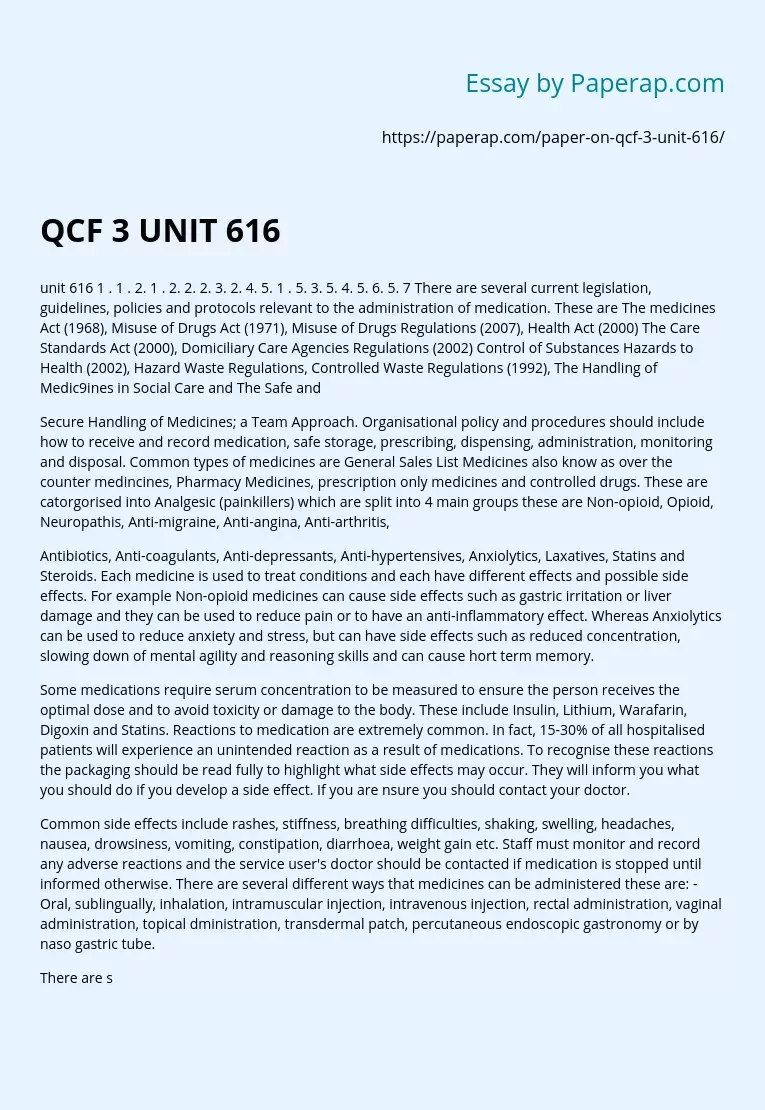Legislation and Policies for Protocols
unit 616 1 . 1 . 2. 1 . 2. 2. 2. 3. 2. 4. 5. 1 . 5. 3. 5. 4. 5. 6. 5. 7 There are several current legislation, guidelines, policies and protocols relevant to the administration of medication. These are The medicines Act (1968), Misuse of Drugs Act (1971), Misuse of Drugs Regulations (2007), Health Act (2000) The Care Standards Act (2000), Domiciliary Care Agencies Regulations (2002) Control of Substances Hazards to Health (2002), Hazard Waste Regulations, Controlled Waste Regulations (1992), The Handling of Medic9ines in Social Care and The Safe and
Secure Handling of Medicines; a Team Approach. Organisational policy and procedures should include how to receive and record medication, safe storage, prescribing, dispensing, administration, monitoring and disposal.
Common types of medicines are General Sales List Medicines also know as over the counter medincines, Pharmacy Medicines, prescription only medicines and controlled drugs. These are catorgorised into Analgesic (painkillers) which are split into 4 main groups these are Non-opioid, Opioid, Neuropathis, Anti-migraine, Anti-angina, Anti-arthritis,
Antibiotics, Anti-coagulants, Anti-depressants, Anti-hypertensives, Anxiolytics, Laxatives, Statins and Steroids. Each medicine is used to treat conditions and each have different effects and possible side effects. For example Non-opioid medicines can cause side effects such as gastric irritation or liver damage and they can be used to reduce pain or to have an anti-inflammatory effect.
Whereas Anxiolytics can be used to reduce anxiety and stress, but can have side effects such as reduced concentration, slowing down of mental agility and reasoning skills and can cause hort term memory.
Some medications require serum concentration to be measured to ensure the person receives the optimal dose and to avoid toxicity or damage to the body. These include Insulin, Lithium, Warafarin, Digoxin and Statins.
Reactions to medication are extremely common. In fact, 15-30% of all hospitalised patients will experience an unintended reaction as a result of medications. To recognise these reactions the packaging should be read fully to highlight what side effects may occur. They will inform you what you should do if you develop a side effect. If you are nsure you should contact your doctor.
Common side effects include rashes, stiffness, breathing difficulties, shaking, swelling, headaches, nausea, drowsiness, vomiting, constipation, diarrhoea, weight gain etc. Staff must monitor and record any adverse reactions and the service user’s doctor should be contacted if medication is stopped until informed otherwise. There are several different ways that medicines can be administered these are: – Oral, sublingually, inhalation, intramuscular injection, intravenous injection, rectal administration, vaginal administration, topical dministration, transdermal patch, percutaneous endoscopic gastronomy or by naso gastric tube.
There are several types of medication, each has a purpose and function needed for their administration via the different routes. Tablets, capsules, liquids, suspensions and mixtures are taken via the oral route. Delivery is straight to the lungs. The delivery route is inhalation. Intramuscular injections are injected directly into large muscles, usually the legs or the bottom. These are performed by a doctor or nurse. Intravenous injections are medicines that re injected into the veins, which is of benefit when a situation in life threatening.
Instillation administration is when medicine is in liquid or suspension form and is instilled via the eye, nose or ears. Drops are available for ear wax removal, glaucoma, dry eyes or eye infections. Nose drops and sprays are available for allergic conditions such as hay fever. Rectal administration is absorbed very quickly by the body. Suppositories can be inserted high into the rectum. Rectal diazepam can be prescribed as treatment for dealing with severe epileptic seizure. Training is required for administration Pessaries or applicators containing creams are effective for treatment of vaginal thrush during the vaginal administration route.
Topical administration is when creams, ointments and gels are applied directly to the skin to treat skin conditions. They can also be used as a delivery route for analgesics (painkillers). Gloves are worn to protect against absorbtion of medication through the skin. Examples of types of medicines used for the Transdermal path route include fentanyl patch, hormone replacement therapy and nicotine patches. The drug is released slowly from the patch over a period of time and is absorbed through the skin into the bloodstream.
For people who are unable to swallow medicines the Percutaneous Endoscopic Gastronomy and Naso Gastric tube routes can be used to administer medication. When administering medication staff must identify the medication correctly, identify the person correctly, know what the medicine is intended to do and know whether any special precautions are needed. If there is a problem with the administration of medication individuals should seek medical ssistance by ringing the doctor or in an emergency by calling 999.
The house manager should also be informed as well as social workers, relevant staff and parents if relevant. It is important to confirm that individuals takes the medication and does not pass it to others as the condition may not be alleviated and may become worse. If the medication is passed and taken to other they may have possible side effects. Out of date and part-used medication should be disposed of at the correct pharmacy. This is then recorded and kept in a file within the workplace.
Legislation and Policies for Protocols. (2018, Jun 16). Retrieved from https://paperap.com/paper-on-qcf-3-unit-616/

